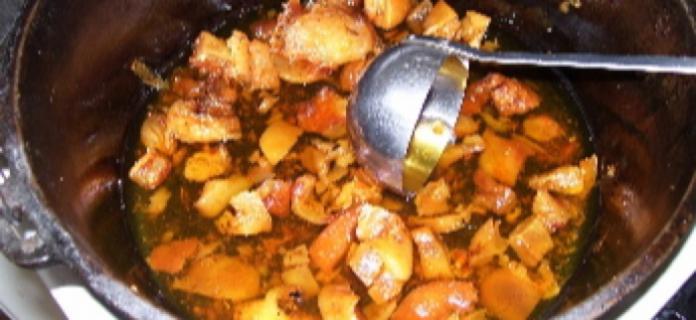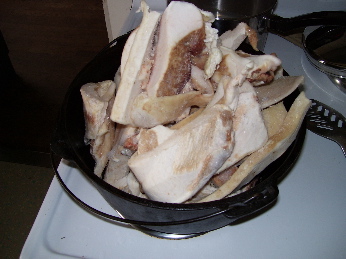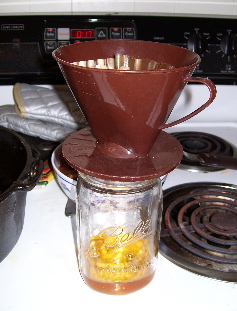Make Your Own Lard

You WHAT?!" said my friend, making the most disgusted face I've seen someone make in some time. I rendered some lard over the weekend, I repeated. "WHY on EARTH would you want to do THAT?!" she cried.
I wasn't surprised. North American culture is so fat-phobic we demonize some of the very foods that are best for us, and among those foods is homemade lard. The store stuff isn't worth bothering with; it's hydrogenated to make it shelf-stable. What I'm talking about is lard from the fat of well-raised pigs, not factory farmed pigs. To get it, you're going to have to make it yourself. Luckily, that's not hard.
What you don't know about lard
Not only does lard make the best pie crusts, it's lower in saturated fat than butter--if saturated fat bothers you. It doesn't bother me, in fact, the plaque levels in my heart have actually improved since I've started eating good saturated fats. (They've actually gone and looked, so I feel safe in saying this.)
Technically lard isn't even a saturated fat; it's a monounsaturated fat. And it's one of the best dietary sources of vitamin D. It also contains no trans-fats. If there's fat to be avoided, trans-fats are the ones.
Finding fat

The hardest part of making lard is finding a good source of pork fat. You're going to have to do a little digging, and it's important that you not just use any pork fat you find; you want to make sure the pig was properly cared for and fed right. Your average supermarket "butcher," and I use that term loosely, isn't going to have it; that pork is all factory farmed, and very few supermarket butchers cut whole carcasses any more. You may have more luck at a specialty market like Whole Foods, Wild Oats or the like, but be sure to inquire after the feeding practices.
If there is a farmer's market near you, look around and ask questions. That's how we stumbled onto our farmer, who is really in the goat cheese biz; he raises pigs on the leftover whey. We've bought two (incredibly delicious) pigs from him in as many years, and surprised the butcher by asking for all of the fat--and as much of the offal as we could get, but that's another article. Hey, we were paying for it. If you don't have a farmer's market, try EatWild.com where you can find farmers with good growing practices, and not just for meat.
Making it
Once you've found your fat, decide what you want to use it for. If you want it for pastries, try to find and use only the fat from around the kidneys--what's called "leaf" lard. I don't make much pastry, so I don't care about that.
Chop the fat into at least 1" cubes, taking any meat chunks off in the process. Some folks put it through a meat grinder. In any event, you want small pieces; otherwise you won't get as much fat out.
Heat your oven to 225°F. I use my cast iron dutch oven to render lard in. Put about a quarter-inch of water at the bottom of the pot; this keeps the fat from browning too much at the beginning, and it'll burn off in time. Add your chopped-up fat. Pop it in the oven for at least a couple of hours, stirring now and then. Eventually the chunks won't give up any more fat--it'll become obvious, the chunks will look the same after an hour as they did before.
As you're doing all this there will be a distinct smell. Some people like it, some people don't. It's a little too intense for my comfort, frankly, which is why I try to do a bunch of lard at once. If you can do this outside, or in a canning kitchen if you have one, so much the better.

Let the lard cool to lukewarm; while it's cooling is a good time to gather up your jars and lids and make sure they're clean and ready to go. There are various methods to filter out the bits of meat and unrendered fat--the cracklings--from the lard, but what I use is a paper coffee filter and cone. Ladle the still-liquid lard, skipping the bigger chunks, into the filter.
Refrigerate the lard and use it within a month. If you've made more than you can use in a month, it freezes well.
Using it
Use it anywhere you'd use butter or shortening: To pop popcorn (the best!); to make pie crust; to fry eggs. In some cultures it's even spread on bread, topped with onions and salt, and called a sandwich. As for the leftover bits, the cracklings? Salt them and put them on salads or just munch on them. Josie loves them. We got more cracklings than we could eat, so we fed a lot of them to the chickens and used them as doggie and kitty treats.
Lynn Siprelle is the editor of TNH.
